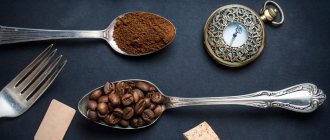Usually people do not doubt the presence of caffeine in coffee, considering it an integral element of the drink. Indeed, this alkaloid determines the well-known strength of the drink. It has no smell, but at high concentrations it gives the drink a noticeable bitterness. The amount of caffeine does not determine either the coffee aroma or the specific taste of the drink. Therefore, it is impossible to say for sure, based only on taste sensations, whether there is caffeine in instant coffee.
Its presence can be indirectly judged by the invigorating effect of drinking a cup of coffee. Caffeine has psychostimulant properties and has both positive and negative effects on the body. Therefore, along with regular instant coffee, manufacturers produce a decaffeinated version.
Caffeine formula
What is instant coffee
This concept hides a powdered, granulated and freeze-dried drink produced using a special technology from substandard Robusta beans, less often Arabica beans.
They are fried, crushed, poured with boiling water and undergo several more complex transformations before reaching the store counter.
Instant coffee always contains caffeine, even if the package is labeled as decaffeinated. The strictest American standards allow up to 3 mg of caffeine in one standard cup of drink. How does a drink made from instant powder differ from a natural one?
- Natural contains a large number of oils, which give it a rich aroma and taste. In soluble they are not present in their natural form due to the peculiarities of the technological process.
- Soluble contains many chemical additives from flavorings and flavor enhancers to artificial oils. This is done in order to bring its taste as close as possible to natural.
- The caffeine content in a cup of instant drink is an order of magnitude higher than in a cup of drink made from natural grains.
Freeze-dried coffee contains more useful substances than powdered coffee, as it is produced using freezing technology
Instant coffee gives a boost of energy by stopping the relaxation reactions that the nervous system sends to the entire body when it needs rest to recuperate. The effect is quick but short-lived and often leads to an even greater desire to rest or even fall asleep.
How was the effect of caffeine studied?
The influence of coffee-containing substances on the body has been repeatedly studied, especially the recently widely advertised instant freeze-dried coffee, its benefits and harms.
Most medical guidelines and recommendations are based on scientific research. This means that respectable doctors shouldn't simply claim that the solution to, say, your lifelong struggle with weight loss is eating acai berries.
Doctors cannot make public statements or health recommendations without reliable scientific research.
Almost anyone can mount a study to show that acai berries are the miraculous answer to our fat-burning dreams. However, scientific papers are divided into good research and not so good research. Conscientious scientists carry out scientific work based on evidence and are subject to certain requirements that prove the correctness of the results obtained:
- The study must be conducted in a very large group of subjects
- The study must have a control group that does not receive the substance, method or treatment ("placebo")
- The study is “double-blind” (meaning that even the scientists do not know which subjects are receiving the real substance and which are receiving a placebo)
- The study must be isolated from the influence of extraneous factors (i.e., if we are studying the harm or benefit of instant freeze-dried coffee, then the subject should not receive any other caffeine-containing substances)
Please keep this in mind when reading other medical scientific papers you find in a google search, whether they concern acai berries, the alleged risks of the measles, mumps, and rubella (MMR) vaccine, or caffeine.
Most studies on this stimulant are in the category of "observational studies," meaning that a group of people who consume the caffeinated substance are followed over a long period. So there is no “control” group, and no one is conducting a double-blind study on all subjects. Thus, there is a tendency for some bias that makes such studies less than ideal.
We know for sure that the caffeine substance affects various organs, causing multicomponent reactions in them: the brain, heart, gastrointestinal tract and even metabolism. Let's discuss what the latest research tells us about the pros and cons of caffeine-like substances.
More than 150 million people in the United States consume caffeine daily, most of them preferring coffee. Other sources of caffeine substrate include tea, soda, chocolate, energy drinks, and dietary supplements in varying concentrations. Consensus in medical circles has determined that this psychostimulant in an amount of approximately 400 mg per day (that's about 3 cups of coffee) is practically harmless. In this case, we talk about moderate coffee consumption.
Read this summary of research on the effects of caffeinated drinks:
Benefits of caffeine
Caffeine substances enhance attention and focus abilities, especially in night shift workers or those who experience jet lag (flying to different time zones, for example). This is why so many people drink coffee drinks, and why many adults with ADHD often self-medicate with caffeine products. Due to this, the first cup of coffee is usually drunk in the morning, immediately after sleep.
This substance may slightly enhance athletic performance.
- The stimulant caffeine may reduce a person's chance of developing Parkinson's disease. The only exception is for postmenopausal women who are taking hormone replacement therapy. In this case, caffeine has the opposite effect. Caffeinated drinks help prevent the development of Alzheimer's disease.
- Caffeine helps prevent cardiovascular diseases such as heart attacks.
- The caffeine substrate reduces the risk of developing diabetes and can reduce insulin resistance in diabetes mellitus in patients who use it regularly.
- Caffeine improves bowel function and is effective for constipation.
- Coffee drinks have a hepatoprotective effect on the liver. Studies show the preventive role of coffee on the development of alcoholic cirrhosis of the liver and the progression of hepatitis C
- Caffeine-containing products may, to some extent, be a means of preventing gout, an acute, severely painful inflammatory condition of the joint (usually the big toe).
People who drink about 2-3 cups of coffee drinks per day also have a reduced risk of death overall, regardless of cause, what is medically called overall mortality.
How much caffeine is in a cup
It is impossible to answer the question with 100% accuracy. The content of the stimulating alkaloid depends on the type of bean, the amount of finished coffee in the cup and the volume of water.
On average, a 250 ml cup can contain from 45 to 100 mg. There is an opinion that the more expensive the drink, the more psychostimulating alkaloid it contains.
Which drink has more caffeine? Instant coffee contains more alkaloid than grain coffee. The difference can reach up to 40 mg. If we are talking about decaffeinated coffee, then the difference increases to 100 units compared to regular natural coffee. To be more precise, you can specify the amount in milligrams of the alkaloid caffeine in a teaspoon. So 3-4 g of soluble it contains about 50 mg, when ground it contains up to 35 mg.
The most energy in a cup of espresso
Robusta beans are inferior to Arabica in terms of caffeine content by about 20 percent, so when purchasing your next package, it doesn’t hurt to study all the information on it in order to navigate the taste and tonic properties of the drink.
What is coffee pods
For your information: in the CIS countries, the granulated drink has become very popular; 80% of the total number of coffee lovers buy it. Only 20% prefer natural.
In the West, these numbers have the opposite meaning and the question is not only about taste preferences, but about the fact that natural coffee is counterfeited much less frequently than instant coffee, and its quality is always higher and is checked more carefully.
How does freeze-dried coffee differ from granulated coffee?
There are no particular differences between the types of instant coffee, except for a slightly improved appearance and taste. Granulated and powdered coffee differ from freeze-dried coffee only in that during their production, the liquid is evaporated from the coffee extract under high temperature. After this, the powder or granules are packaged.
Of course, freeze-dried coffee also differs favorably in appearance, since it is more similar in shape and color to coffee beans. In addition, it is more aromatic and has a pleasant, mild taste.
Does freeze-dried coffee have caffeine?
How much caffeine is in freeze-dried coffee: A cup of freeze-dried coffee contains approximately 60-80 mg of caffeine, depending on the brand and variety used. When producing coffee extract from technical Robusta varieties, there is always more caffeine. There is practically decaffeinated coffee - no more than 0.3%.
Is it possible to drink coffee in the morning
Dosage and overdose
In the West and in America, a single dose of coffee with a caffeine content of 80-100 mg is considered safe. That is, a cup consisting of 2 tablespoons of instant and 3 tablespoons of ground will not cause harm to health and will have a stimulating and tonic effect for the next 3 hours. The daily dosage of the alkaloid should not exceed 350-400 ml, that is, 3-4 cups.
Cigarettes and instant coffee are the main enemies of the cardiovascular system
For hypertensive patients, diabetics, people suffering from ulcers and gastritis, it is especially important to know whether there is caffeine in the drink they drink and what its content is. These categories of lovers of an invigorating drink usually experience a rapid heartbeat, a rise in blood pressure up to 10 units and abdominal pain after drinking a cup of their favorite drink. They are recommended to drink coffee that does not contain caffeine, but does not differ in taste from a regular drink.
How much can you drink? The dosage is small - 1-2 cups per day, since a small proportion of the alkaloid, which is unsafe for them, will still enter the body.
By adhering to the golden rule - “everything should be in moderation”, you can enjoy the most popular drink in the world every day and not harm your health.
Caffeine – harm or benefit?
Do you agree that it’s time for us to discuss caffeine, as well as instant freeze-dried coffee, the benefits and harms of its use, which are so debated in society? It is a fact that caffeine-containing products are the most accessible and widespread in the world.
(I suggest you familiarize yourself with the collection, which contains not only healthy, but also inexpensive and tasty dishes for pancreatitis).
These are tea, coffee drinks, chocolate, cocoa, etc. We must not forget about the abuse of various invigorating drinks such as cola and various energy drinks.
Perhaps due to the widespread consumption of caffeine, there are far more myths and fables surrounding this stimulant than any other.
We once discovered that it was the fountain of youth and longevity, and subsequently proclaimed that more than one drop of a caffeinated drink could send us to the grave.
The effect of caffeine on the human body
There is still no definitive consensus in the medical community whether psychostimulants should be recommended. But first, let's look at what we know about caffeine.
How to produce
The process of obtaining freeze-dried coffee is aimed at extracting the maximum amount of flavoring and aromatic substances from natural beans. Selected coffee beans are used for production - this guarantees a high-quality finished product.
The grains are first fried, gases are removed from them and ground to a powdery state. Then the grinding is poured into special sealed metal containers and boiled for several hours. The steam generated during cooking is directed through pipes. Along with the steam, essential oils are also released, which will later be needed to add flavor to the drink.
The resulting coffee mass is subjected to shock freezing, then vacuum removal of moisture occurs. This drying method makes the composition of the freeze-dried product closest to natural.
The thoroughly dried concentrate is crushed into small crystals.
At the last stage, the specific coffee taste and aroma are returned to the granules. To do this, they are soaked in essential oils in combination with additional flavors. Next, they are packaged in airtight packaging.
Coffee granules of the same size are considered an indicator of correct adherence to the preparation procedure. To visually see the quality, it is better to buy products in transparent jars.










